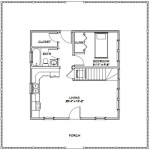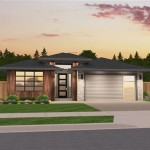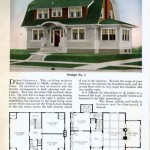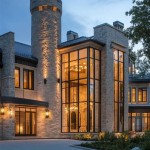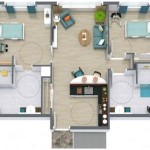Garage House Floor Plans are a type of architectural plan specifically designed for houses that have an attached or detached garage. These plans provide detailed information about the layout and structure of the garage, including its size, shape, and location relative to the rest of the house. Garage House Floor Plans are essential for ensuring that the garage is properly integrated into the overall design of the house and meets the specific needs of the homeowner.
For example, a family with multiple cars or a need for additional storage space may require a garage with a larger footprint and multiple entry points. Conversely, a homeowner with limited space may opt for a smaller garage with a more compact design. Garage House Floor Plans allow architects and builders to customize the garage to suit the unique requirements of each individual project.
In the following sections, we will delve into the key elements of Garage House Floor Plans, explore different design options, and provide valuable tips for creating a garage that meets your specific needs and enhances the overall functionality of your home.
When designing a garage house floor plan, there are several important points to consider:
- Size and shape
- Location
- Entry points
- Storage space
- Lighting
- Ventilation
- Safety features
- Future expansion
- Cost
By carefully considering these factors, you can create a garage house floor plan that meets your specific needs and enhances the overall functionality of your home.
Size and shape
The size and shape of your garage will be determined by a number of factors, including the number of cars you need to accommodate, the amount of storage space you require, and the overall size and layout of your property.
- Single-car garages are the most common type, and they typically measure around 12 feet wide by 20 feet deep. This size is large enough to accommodate a single car, but it may be too small for larger vehicles or if you need additional storage space.
- Two-car garages are a good option for families with multiple cars. They typically measure around 20 feet wide by 20 feet deep, which provides enough space for two cars and some additional storage.
- Three-car garages are less common, but they can be a good option for families with multiple cars or who need a lot of storage space. They typically measure around 30 feet wide by 20 feet deep.
- Custom-sized garages can be designed to meet your specific needs. If you have a large property or a unique vehicle, you may want to consider a custom-sized garage.
The shape of your garage will also be influenced by the size and layout of your property. If you have a narrow lot, you may need to opt for a long and narrow garage. If you have a large lot, you may have more flexibility in terms of the shape of your garage.
Location
The location of your garage will be determined by a number of factors, including the size and layout of your property, the accessibility of the garage from the street, and the proximity of the garage to the house.
- Attached garages are connected to the house, typically through a breezeway or mudroom. Attached garages are convenient and provide easy access to the house, but they can also be more expensive to build than detached garages.
- Detached garages are located separate from the house. Detached garages are less convenient than attached garages, but they can be less expensive to build and they can provide more flexibility in terms of size and location.
- Front-load garages have the garage door facing the street. Front-load garages are the most common type of garage, and they are typically the most affordable to build. However, front-load garages can take up a lot of space in the front of the house, and they can be less convenient if you have a long driveway.
- Side-load garages have the garage door facing the side of the house. Side-load garages are less common than front-load garages, but they can be more convenient if you have a long driveway. Side-load garages can also be more aesthetically pleasing, as they do not take up as much space in the front of the house.
When choosing the location of your garage, it is important to consider your specific needs and preferences. You should also consider the impact that the garage will have on the overall appearance of your home.
Entry points
The number and location of entry points to your garage will be determined by a number of factors, including the size and layout of your garage, the accessibility of the garage from the street, and the proximity of the garage to the house.
- Main entry door
The main entry door to your garage should be located in a convenient location, such as near the kitchen or mudroom. The door should be large enough to allow for easy access, and it should be well-lit and secure.
- Secondary entry door
A secondary entry door to your garage can be useful if you need to access the garage from the backyard or from another part of the house. The secondary door should be smaller than the main entry door, and it can be less secure.
- Garage door
The garage door is the main entry point for vehicles. The garage door should be large enough to accommodate your vehicles, and it should be well-maintained and secure.
- Windows
Windows in the garage can provide natural light and ventilation. Windows should be placed high on the walls to prevent break-ins.
When choosing the entry points for your garage, it is important to consider your specific needs and preferences. You should also consider the impact that the entry points will have on the overall security and functionality of your garage.
Storage space
Garage House Floor Plans should include ample storage space to accommodate your vehicles, tools, and other belongings. The amount of storage space you need will depend on a number of factors, including the size of your garage, the number of vehicles you own, and your hobbies and interests.
If you have a small garage, you will need to make the most of the space you have. Consider installing shelves, cabinets, and overhead storage racks to maximize your storage capacity. You can also use the walls of your garage to hang tools and other items.
If you have a larger garage, you may want to consider dedicating a specific area to storage. This could include a separate storage room or a designated area for shelves, cabinets, and other storage solutions.
No matter how much storage space you have, it is important to keep your garage organized. This will help you to find what you need quickly and easily, and it will also help to prevent accidents.
By carefully considering your storage needs, you can create a Garage House Floor Plan that meets your specific requirements and helps you to keep your garage organized and functional.
Lighting
Proper lighting is essential for a safe and functional garage. When designing your Garage House Floor Plan, be sure to consider the following lighting points:
- General lighting
General lighting provides overall illumination for your garage. It should be bright enough to allow you to see clearly in all areas of the garage, but it should not be so bright that it is uncomfortable or glaring. Fluorescent lights or LED lights are a good option for general lighting.
- Task lighting
Task lighting is used to illuminate specific areas of your garage, such as your workbench or storage areas. Task lighting can be provided by under-cabinet lights, pendant lights, or spotlights.
- Natural lighting
Natural lighting is the best type of lighting for your garage. If possible, design your garage with windows or skylights to allow natural light to enter. Natural lighting can help to reduce your energy costs and it can also make your garage more pleasant to use.
- Motion sensor lights
Motion sensor lights are a great way to save energy and improve security. Motion sensor lights turn on automatically when they detect movement, and they turn off automatically after a set period of time. This can help to prevent you from leaving your garage lights on accidentally, and it can also deter burglars.
By carefully considering these lighting points, you can create a Garage House Floor Plan that provides adequate lighting for all of your needs.
Ventilation
Proper ventilation is essential for a healthy and safe garage. Good ventilation helps to remove harmful fumes, dust, and moisture from the air. This can help to prevent respiratory problems, allergies, and other health issues.
There are two main types of ventilation systems for garages: natural ventilation and mechanical ventilation. Natural ventilation relies on the natural movement of air to remove fumes and moisture from the garage. This can be achieved by opening windows and doors, or by installing vents in the walls or roof of the garage.
Mechanical ventilation uses fans or blowers to remove fumes and moisture from the garage. Mechanical ventilation systems are more effective than natural ventilation systems, but they can also be more expensive to install and operate.
When designing your Garage House Floor Plan, be sure to consider the following ventilation points:
- The size of your garage
- The number of vehicles you park in your garage
- The types of activities you perform in your garage
- The climate in your area
By carefully considering these factors, you can choose the best ventilation system for your garage and ensure that your garage is a healthy and safe environment.
In addition to the above, you may also want to consider installing a carbon monoxide detector in your garage. Carbon monoxide is a colorless, odorless gas that can be fatal if inhaled. Carbon monoxide can be produced by vehicles, generators, and other fuel-burning appliances. A carbon monoxide detector will sound an alarm if the level of carbon monoxide in your garage becomes dangerous.
Safety features
Garage House Floor Plans should include a number of safety features to help prevent accidents and injuries. These features include:
- Proper lighting
Good lighting is essential for a safe garage. It helps you to see clearly and avoid tripping or bumping into objects. Install bright, energy-efficient lights throughout your garage, and be sure to place them in areas where you need them most, such as near your workbench and storage areas.
- Slip-resistant flooring
Slip-resistant flooring is important for preventing falls, especially in wet or oily garages. Choose a flooring material that has a high coefficient of friction, such as concrete, epoxy, or rubber.
- Clear walkways
Keep all walkways in your garage clear of clutter and obstacles. This will help to prevent you from tripping or falling.
- Fire extinguishers
Fire extinguishers are essential for putting out small fires. Keep a fire extinguisher in your garage, and be sure to know how to use it.
By including these safety features in your Garage House Floor Plan, you can help to create a safe and functional space for your family and friends.
Future expansion
When designing your Garage House Floor Plan, it is important to consider future expansion. You may not need a large garage right now, but your needs may change in the future. For example, you may decide to add a new car to your family, or you may start a new hobby that requires more space. By planning for future expansion, you can avoid the need to make costly renovations down the road.
There are a number of ways to design your Garage House Floor Plan for future expansion. One option is to build a garage that is larger than you need right now. This will give you the flexibility to add more cars or storage space in the future. Another option is to design your garage with a modular layout. This will allow you to add on to your garage in the future without having to make major structural changes.
If you are not sure how you might use your garage in the future, it is a good idea to design your Garage House Floor Plan with a flexible layout. This will give you the freedom to change the use of your garage as your needs change. For example, you could design your garage with a large open space that can be used for parking, storage, or a workshop. You could also design your garage with a separate room that can be used for a home office, a gym, or a playroom.
By planning for future expansion, you can create a Garage House Floor Plan that will meet your needs both now and in the future.
Here are some additional tips for designing your Garage House Floor Plan for future expansion:
- Choose a garage door that is larger than the width of your current vehicles. This will give you the flexibility to add larger vehicles in the future.
- Install a high ceiling in your garage. This will give you the option to add a loft or mezzanine level in the future.
- Run electrical and plumbing lines to areas of your garage where you may want to add future additions, such as a workshop or a bathroom.
- Consider adding a foundation that is larger than your current garage. This will give you the option to expand your garage in the future without having to dig a new foundation.
Cost
The cost of a Garage House Floor Plan will vary depending on a number of factors, including the size of the garage, the complexity of the design, and the materials used. However, there are some general tips you can follow to save money on your Garage House Floor Plan:
- Choose a simple design
Complex designs will require more time and materials to build, which will increase the cost. Choose a simple design that meets your basic needs.
- Use less expensive materials
There are a variety of less expensive materials that can be used to build a garage, such as vinyl siding, metal roofing, and concrete floors. These materials will help to keep the cost of your garage down.
- Do some of the work yourself
If you are handy, you can save money by doing some of the work yourself, such as framing the walls, installing the drywall, and painting the garage. However, be sure to hire a qualified contractor to do any electrical or plumbing work.
By following these tips, you can save money on your Garage House Floor Plan without sacrificing quality or functionality.










Related Posts

